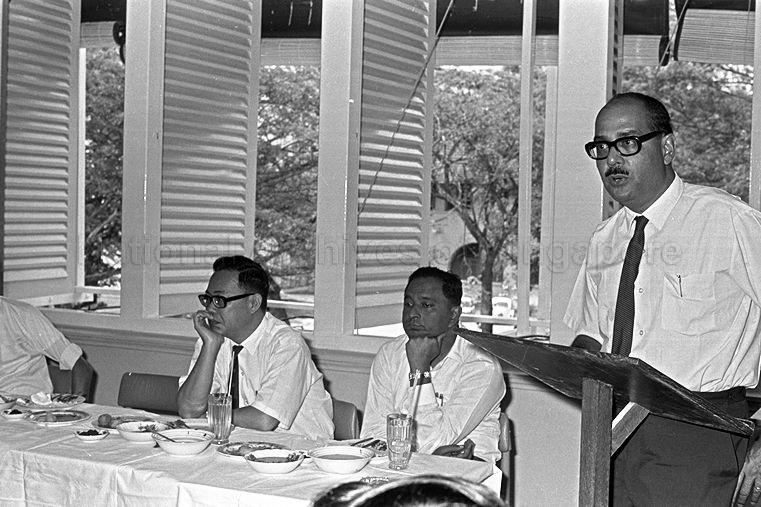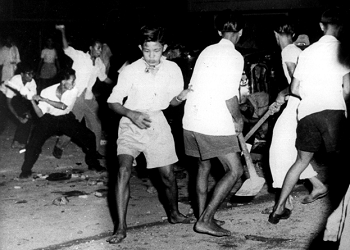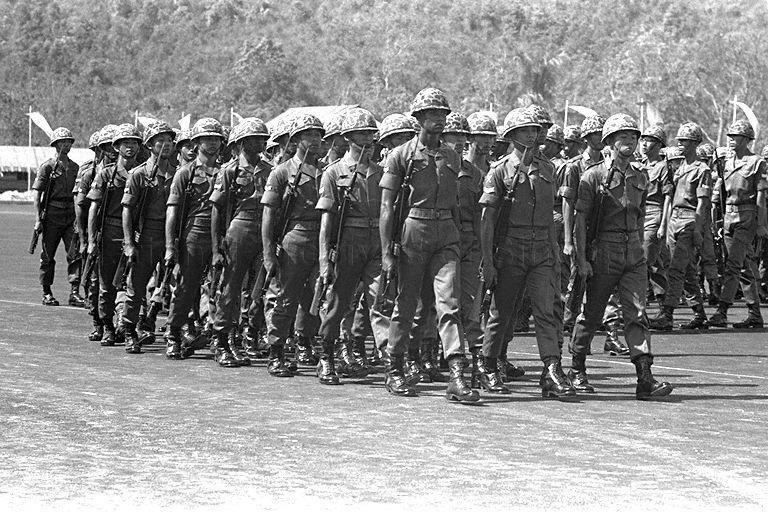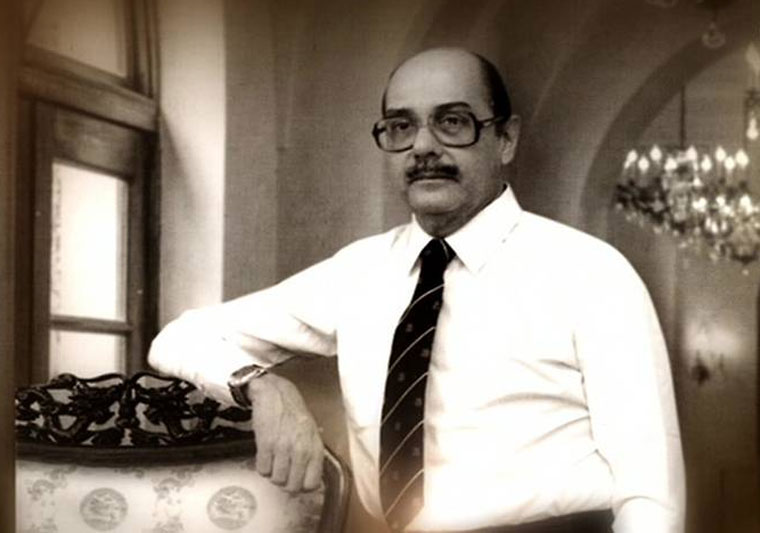In August 2016, SR Nathan’s passing led to commemorations of his contributions to Singapore’s security interests, as both a pioneer civil servant and President of Singapore.
Contributions by the likes of SR Nathan and Goh Keng Swee to Singapore’s security interests are well-known, documented and recognised. However, there are others who have overcome the odds in shaping Singapore’s security landscape.
George Bogaars is one such individual.
[caption id="" align="aligncenter" width="761"] George Bogaars - First from Right. Photo from nas.gov.sg[/caption]
George Bogaars - First from Right. Photo from nas.gov.sg[/caption]
Joining the Civil Service
In 1952, Bogaars had just joined the civil service under the British colonial government. Singapore saw three colonial governors that year, the outgoing Sir Franklin Charles Gimson, acting governor Wilfred Lawson Blythe, and Sir John Fearns Nicoll, who would serve till 1955.
Up till that point in his life, Bogaars had lived through the Japanese Occupation from 1942 to 1945, a state of emergency brought about by the communist threat, Maria Hertogh riots, and many strikes by workers in public transportation and public services.
Bogaars had big shoes to fill in the civil service. His father had served as the confidential secretary to four British governors.
Fortunately, however, British colonial authorities had just begun to accept Singaporeans into the elite Administrative Service, and Bogaars was a pioneer recruit. He rose quickly through the ranks, becoming the acting deputy secretary of the Treasury in 1955.
Heading Special Branch
[caption id="" align="aligncenter" width="624"] Special Branch headquarters at Robinson Road. Photo from MHA[/caption]
Special Branch headquarters at Robinson Road. Photo from MHA[/caption]
By 1959, Bogaars became the first Singaporean to head Special Branch -- the forerunner of the Internal Security Department. According to the documentary series Men With A Mission by Mediacorp, Bogaars was also the first non-police officer to head it. He was also tasked to revamp it.
At this point in his career, Bogaars had already worked under the David Marshall and Lim Yew Hock governments, and experienced the Anti-National Service Riots in 1954, the Hock Lee bus riots in 1955, and a multitude of demonstrations and riots that involved pro-communists.
[caption id="" align="aligncenter" width="350"] Photo from here[/caption]
Photo from here[/caption]
The year 1959 saw many turning points in Singapore’s history. The British had granted Singapore full self-government, Yusof Ishak had been appointed by Queen Elizabeth II to be Singapore’s Head of State, and the People’s Action Party won the general elections, which made Lee Kuan Yew Prime Minister.
The communists were a constant threat to Singapore’s stability. They had infiltrated various organisations, such as trade unions and middle schools, and were causing unrest through them. Furthermore, they were threatening to turn Singapore into a Communist State.
Finally, on Feb. 2, 1963, Bogaars ran Operation Coldstore, which led to over a hundred arrests.
The operation effectively crippled the suspected communists, and removed them as a threat to Singapore.
Laying the foundations for the SAF
When Singapore became independent in 1965, Bogaars became permanent secretary to the Ministry of Interior and Defence, serving under Goh Keng Swee.
By then, Bogaars would have lived through the racial riots of 1964 and Indonesia’s Konfrontasi against the formation of Malaysia.
A newly independent Singapore, which had previously relied upon the British and Malaysian armed forces for defence, faced an urgent need to build up its own defences.
It was an uphill task, as Singaporeans back then were not receptive to the idea of serving in the military, let alone conscription.
Nevertheless, Bogaars helped to establish the Singapore Armed Forces Training Institute (SAFTI) in 1966. SAFTI laid the foundation for the SAF by training the pioneer batch officers, who would later play a crucial role in training and leading the first batch of National Servicemen.
[caption id="" align="aligncenter" width="768"] Photo from here[/caption]
Photo from here[/caption]
Following that, he also oversaw the enlistment of Singapore’s pioneer batch of National Servicemen. To get the population round to the idea of conscription, he organised successful open houses at army camps and send-off parties at community centres.
Bogaars’ efforts in establishing the SAF, alongside Goh Keng Swee, secured Singapore’s defence interests.
Bogaars would go on to become Head of the Civil Service in 1968 and chairman Keppel Shipyard in 1970.
He passed away in 1992 at the age of 65.
Related article:
Relive the key moments of the Maria Hertogh riots as a young Malay man
Top photo via Toggle
If you like what you read, follow us on Facebook and Twitter to get the latest updates.
If you like what you read, follow us on Facebook, Instagram, Twitter and Telegram to get the latest updates.
